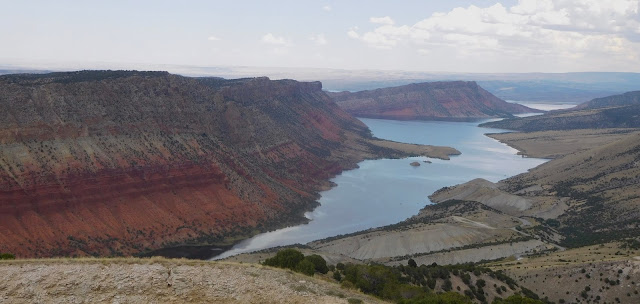Carol writes: We chose Flaming Gorge National Recreation Area that straddles the Utah/Wyoming border as our campsite from which to observe the August 21st eclipse of the sun. It was easy to understand why John Wesley Powell selected the name Flaming Gorge for this fabulously scenic gorge during his exploration down the Green River in 1869.
Perhaps Powell also experienced a few sunsets like we savored at our camp, and thus, the aptness of the name Flaming Gorge was sealed.
The reservoir at Flaming Gorge was created in 1964 when a dam was constructed across the Green River, resulting in a wildly scenic recreation area that is quite popular with campers, fishermen, and boaters. Much of the canyon that so captured John Wesley Powell’s imagination is now submerged beneath the water of the reservoir, but those eye-catching 220-million-year-old rusty-red Moenkopi mudstone layers have remained exposed, much to the delight of Flaming Gorge visitors.
At our Lucerne Valley campsite on the shoreline of the reservoir,
we had an especially ideal spot to experience our 94% portion of the solar eclipse. No special eclipse-viewing glasses for us, just the ole pinhole in the card technique.
At the moment of maximum eclipse, our 94% of totality produced an eerie lighting effect, but nothing close to the spectacular darkness in the totality zone just a hundred miles north of us.
Our campground at Flaming Gorge provided a constant steam of intriguing animal life. The local pronghorn have adopted this campground as their home, most likely because of the plentiful supply of water and endless tasty greens. Prior to this, we had only seen pronghorn grazing in prairies at a distance along the highway, so it was quite special to see them up close. Surprisingly, they weren’t at all spooked by humans.
This campground also had a family of osprey that had built their nest just on the edge of the campground. Two adults and two juveniles spent much of the day flying around while generating frequent bursts of high-pitched chirps.
Watching the boaters return every day and hearing their stories of good luck fishing on the reservoir made me a bit envious. However, as our neighbors were leaving at the conclusion of the eclipse, they graciously offered me the singleton kokanee salmon they had just caught, then surprisingly added in a bag of frozen kokanee!
Supper that evening of grilled fresh kokanee salmon was out of this world!

To round out our animal experiences at Flaming Gorge, we spotted this bighorn sheep just before it made a mad dash across the road to higher ground.
DUBOIS, WYOMING
From Flaming Gorge we headed up into west central Wyoming to the little town of Dubois (pronounced “do-boys” by the locals) for a little downtime.
Al had his sights set on a little hiking, but after we had been warned more than once that if we intended to hike we should buy bear spray and learn how to use it, we got the message that this was big-time grizzly bear and black bear country.
I balked at the forested hikes where grizzlies were more likely to be found, and as the days played out, Al didn’t rush out to tackle any forested hike on his own. Instead, we relished some exceptionally colored scenic hikes in the BLM (Bureau of Land Management) badlands around Dubois, the so-called Wind River Badlands, where I was certain there were no bears of any kind.
A local museum employee told us exactly where to enter the badlands, and all about some fossilized treasures called “algae balls” that we could look for. We spent two days hiking trails in a sagebrush and greasewood shrub habitat surrounded by dramatic candy-striped red and white sandstone, silt, claystone, and other conglomerate layers.
On the second day we were rewarded with the discovery of those puzzling “algae balls” that we had been told about. Algal balls are fossil remains of concentric layers of algae which built up on tiny pebbles, or little snails, many millions of years ago.
We rounded out our week in Dubois with a visit to the Dubois Fish Hatchery, where hundreds of thousands of trout and grayling are raised as stock for Wyoming reservoirs, lakes, and streams.
And, of course, we had to check out the local venue of ancient Indian rock art.
That was positively an interesting and relaxing first week in Wyoming…
Just recently, I saw a license plate from West Virginia with the proud slogan stating that West Virginia is “wild, wonderful.” Even though another “W” state had that nickname first, having spent the last 10 days in the land of a flaming gorge, grizzlies, and the panorama of geologic history, I think that slogan would apply equally to the state of Wyoming. From Dubois, we are just a short drive to Grand Teton National Park, where we hope to experience some of the highlights of our summer in the West.
“Wander everywhere, but always wonder.” Sign seen on the side of a motorhome























No comments:
Post a Comment